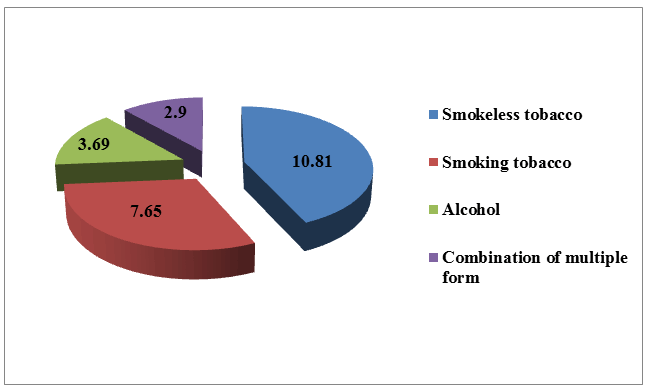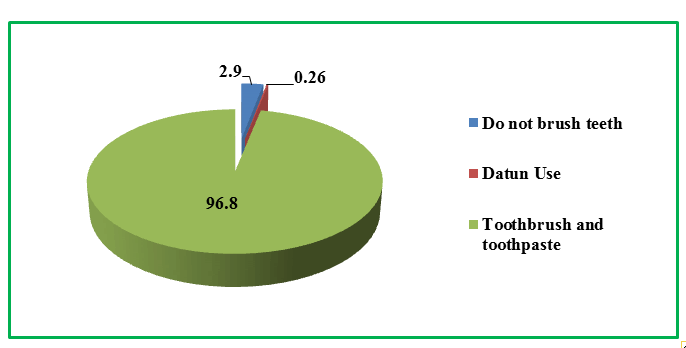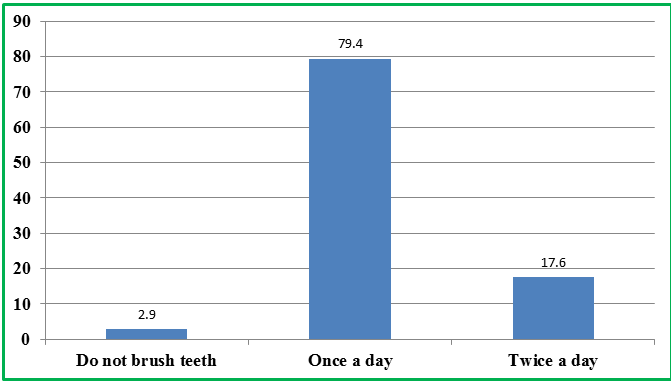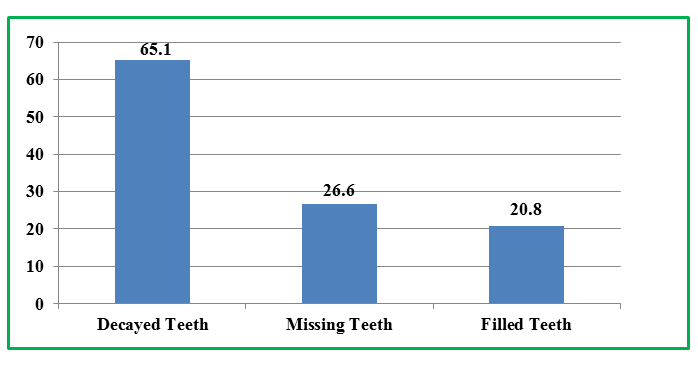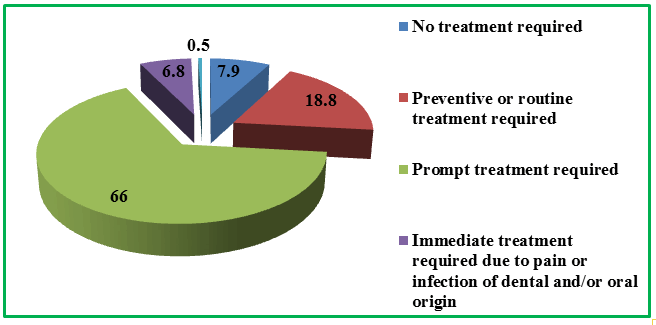ISSN : 2576-392X
Dentistry and Craniofacial Research
ORAL HEALTH STATUS OF PARTICIPANTS VISITING A DENTAL EXHIBITION AT A TERTIARY CARE CENTRE
PriyaHarsh*
All India Institute of Medical SciencesVerified email at aiims.gov.in
*Corresponding author:Priya Harsh1 All India Institute of Medical Sciences verified email at aiims.gov.in India; Tel: 9952428836; E-mail:suhasishray@gmail.com.
Received date: October 30, 2020; Accepted date: August 13, 2021; Published date: August 24, 2021
Citation:Priya Harsh (2021) Oral Health Status Of Participants Visiting A Dental Exhibition At A Tertiary Care Centre J Dent CraniofacRes Vol.6 No.3
Abstract
Introduction:
Tertiary care centers are usually associated with teaching hospitals equipped with sophisticated diagnostic and treatment facilities, as well as sub-specialty resources, not available at general hospitals. An exhibition at a tertiary care centre offers a confluence of patients, doctors, professionals and individuals from different forms of society.
Materials and Method:
A descriptive cross-sectional study on 379 patients was conducted to assess the oral health status, different oral hygiene practices and adverse habits amongst the individuals visiting the exhibition in a tertiary care hospital. A structured proforma assessed the oral hygiene practices and adverse habits amongst the individuals. WHO Oral health assessment form 2013 for adults was used to record the oral health status of the individuals.
Results:
334 (88.12%) participants denied consumption of any form of smokeless tobacco whereas 4.48% reported alcohol consumption in the present study. 367 (96.8%) were using toothbrush and toothpaste to clean their teeth and majority 79.4 % brushed their teeth once. 247 participants (65.1%) had decayed teeth, 101 (26.6%) had missing teeth and 79 participants (20.8%) had filled teeth. The mean DT, MT, FT in the present study was found to be 2.15+2.84, .98+3.03 and .52+1.42.
Conclusion:
Dental caries status in the participants attending the exhibition at a tertiary care centre was found to be high. This study emphasized the need for strong referral linkages and integrated approach for comprehensive treatment.
Introduction
Health continues to be a neglected entity despite continuous efforts for health promotion, worldwide. Health is often taken for granted, and its value is not fully understood, until it is lost.1 The compartmentalization involved in viewing the mouth separately from the rest of the body must cease because oral health affects general health by causing considerable pain and suffering and by changing what people eat, their speech and their quality of life and well-being.2 Because of the failure to tackle social and material determinants and incorporate oral health into general health promotion, millions suffer intractable toothache and poor quality of life and end up with few teeth.3
Oral health affects people physically and psychologically and influences how they grow, enjoy life, look, speak, chew, taste food and socialize, as well as their feelings of social well-being.4 Oral diseases are the most common of the chronic diseases and are important public health problems because of their prevalence, their impact on participants and society, and the expense of their treatment. The determinants of oral diseases are known — they are the risk factors common to a number of chronic diseases: diet and dirt (hygiene), smoking, alcohol, risky behaviors causing injuries, and stress — and effective public health methods are available to prevent oral diseases.3
A tertiary care center is defined as specialized consultative care provided by specialists working in a center that has personnel and facilities for special investigation and treatment of complicated medical conditions. Tertiary care centers are usually associated with teaching hospitals equipped with sophisticated diagnostic and treatment facilities, as well as sub-specialty resources, not available at general hospitals.5 An exhibition at a tertiary care centre offers a confluence of patients, doctors, professionals and individuals from different forms of society.
Numerous studies in the past has revealed a variety of work-related oral health problems, including associations between declining work performance and temporo-mandibular joint related pain,6 and frequent bruxism and working stress.7 Moreover, other studies have revealed high levels of work-related stress in workers whose self-evaluation of oral health status was poor 8,9 and association of work-related psychological dependency, psychological stress due to workload, and other workplace parameters with periodontal diseases.10
All India Institute of Medical Sciences, New Delhi, a tertiary care hospital in India celebrated its 63rd Institute Day on 25th September 2018, and an exhibition by all the professional and paraprofessionals departments was displayed from 25th to 30th September 2018. The Centre for Dental Education and Research CDER, AIIMS set up a dental booth equipped with two fully functional portable dental chairs during the six day exhibition and the booth was awarded with “Best Exhibit” during the exhibition.
In a generation where evidence holds the key, scientifically testing the basic concept of oral diseases among individuals with diverse backgrounds should be of utmost importance. An analysis of existing literature also reveals scarcity in determination of oral health status of such varied group of individuals visiting a exhibition in a tertiary care centre. Hence the present study was aimed to assess the oral health status of individuals visiting dental exhibition at a tertiary care centre. The present study also assessed various oral hygiene practices and adverse habits among the study individuals.
Materials and Method
A descriptive cross-sectional study was conducted to assess the oral health status, different oral hygiene practices and adverse habits amongst the individuals visiting the exhibition in a tertiary care hospital. The study is a total enumeration of 379 participants fulfilling the inclusion criteria.
Permissions for conducting study and clinical examinations were obtained from the respective authorities. Written informed consent for participation was obtained prior to conduction of study.
Inclusion and Exclusion Criteria
Participants willing to participate and intellectually and physically capable of responding were included, whereas the participants with the inability to cooperate with the study protocol were excluded from the present study.
Sample Size
The study is a total enumeration of the entire participants visiting the exhibition during the 6 days, fulfilling the inclusion criteria. The booth had a footfall of 413 participants during the time period; however, 379 underwent oral examination. Thus, the final sample size of the present study consisted of 379 participants.
Training and Calibration
Training and calibration of the examiners was carried out at Centre for Dental Education and Research, AIIMS New Delhi, under the guidance of an expert examiner. Clinical training and calibration was done first by practicing on group of 10 participants and then on 20 participants twice with time interval of half an hour and with a wide range of level of disease conditions. This was done to ensure uniform interpretation, understanding and application of the codes and criteria for various conditions to be observed and recorded. The Kappa value (0.8) for calibration exercise showed substantial agreement for observations and measurement.
Measurement tools
A structured proforma assessed the oral hygiene practices and adverse habits amongst the individuals. WHO Oral health assessment form 2013 for adults was used to record the oral health status of the individuals.11
Data collection
Five trained investigators carried out the oral examination of all the individuals. The clinical examination and recording took about 5-10 minutes per individual. The clinical examination involved an inspection of the oral cavity with plane mouth mirror and community periodontal (CPI) probe under good illumination.
The data collected was entered in Microsoft Excel and subjected to statistical analysis using Statistical Package for Social Sciences (SPSS, IBM version 20.0). Descriptive statistics was used to determine the frequencies, mean and standard deviation of variables considered in the study.
Results
An assessment of 379 participants in the present study revealed that 29.19% were females and 70.8 % were males. Approximately 52% were working in the tertiary care centre AIIMS, whereas 46.3 % were patients or individuals visiting the exhibition. 334 (88.12%) participants denied consumption of any form of smokeless tobacco, 346 (91.29%) of smoking tobacco and only 4.48% reported alcohol consumption in the present study.
The most commonly (96.8%) used oral hygiene aid in the present study was toothbrush and toothpaste whereas the frequency of brushing in majority (79.4 %) of cases in the present study was found to be once.
In the present study 247 participants (65.1%) had decayed teeth, 101 (26.6%) had missing teeth and 79 participants (20.8%) had filled teeth. The mean DT, MT, FT in the present study was found to be 2.15+2.84, .98+3.03 and .52+1.42 (Table 1).
| Variable | Mean | Standard Deviation | Minimum | Maximum |
|---|---|---|---|---|
| Decayed Teeth | 2.84 | 0 | 22 | |
| Missing Teeth | 0.98 | 3.03 | 0 | 32 |
| Filled Teeth | 0.52 | 1.42 | 0 | 13 |
Table 1: Mean decayed, missing and filled teeth among the screened participants.
| Variable | Number | Percentage | |
|---|---|---|---|
| Upper Dentures wearer | Partial Denture | 2 | 0.52 |
| Complete Denture | 4 | 1.05 | |
| Total | 6 | 1.58 | |
| Lower Dentures wearer | Partial Denture | 1 | 0.26 |
| Complete Denture | 2 | 0.52 | |
| Total | 3 | 0.79 | |
| Total | 9 | 2.37 | |
Table 2: Denture usage among the screened individuals.
| Dental Erosion | Number | Percentage |
|---|---|---|
| No sign of erosion | 367 | 96.8 |
| Enamel lesion | 3 | 0.79 |
| Dentinal lesion | 8 | 2.11 |
| Pulp involvement | 1 | 0.26 |
Table 3: Dental Erosion seen in the screened participants (%).
The root caries prevalence in the present study was found to be 15.3%.55.1% reported signs of bleeding whereas as an assessment of periodontal conditions in the present study revealed pockets in 7.65% population and loss of attachment in 23.5 % population. An assessment of interventional urgency during the dental camp at the exhibition revealed that 66% of the participants required prompt treatment.
Discussion
The present study conducted was unique and one of it’s kind. Hence the results cannot be compared directly with results of any other study. The differentiating feature of the present study was the inclusion of a diverse population of patients, doctors, staff members and participants from different sections of the society visiting a general health exhibition of which oral health exhibition was a part. The assessment of oral health status, oral hygiene and adverse habits among 379 participants visiting exhibition in a tertiary care hospital is reported and discussed here.
In the present study 37.9 % participants belonged to the age group of 30 years whereas 62.1% were more than 30 years old. The present study reported a male predominance (70.8%) with only 29.19 % female participants. In line with the results of the present study, Amaral COF et al., 12 in their study on oral health status in hospitalized patients also reported male predisposition. Majority of participants in the present study denied consumption (88.12 %) of smokeless/smoking tobacco or alcohol. In contrast to the results of the present study, I. Vagropoulos et al., 13 reported 50 % prevalence of smoking habits among the hospital staff of a general hospital. Gutkha chewing followed by tobacco and lime was found to be the chief form of smokeless tobacco consumed. Gutkha consumption warrants every state and not just individual states to ban gutkha and pan masala containing tobacco.14 In contrast to the results of the present study, Goyal et al., 15 reported that 21.6 % young adults in the Northern Indian population consumed tobacco. The low prevalence of tobacco consumption in the present study is attributed to the prohibition of tobacco consumption and sale around the tertiary care hospital. Cigarette smoking was the most common form of smoking tobacco, the results of the study correlate with study by Sujata Mishra et al., 16 who also reported a rise in cigarette smoking in Delhi region from past years.
The information regarding oral hygiene practices revealed that 96.8% used toothbrush and toothpaste to clean their mouth and the frequency of brushing in majority of participants was once daily (79.4%). A comparative evaluation of the categorized age group (less than or equal to 30 and more than 30 years) revealed that majority of participants with age above 30 years (70 %) brushed twice daily.
Bobby Paul et al., 17 in their study on oral hygiene awareness and practices in Kolkata reported that 69.20 % participants used both toothbrush and toothpaste together and the frequency of cleaning once and twice daily were found to be 58.93% and 35.71% respectively.
247 participants (65.1%) had decayed teeth, 101 (26.6%) had missing teeth and 79 participants (20.8%) had filled teeth. 65.44 % participants with age more than 30 years had decayed teeth. The mean DT, MT, FT in the present study was found to be 2.15+2.84, .98+3.03 and .52+1.42. P.D Garkoti et al., 18 reported 54.54 % prevalence of dental caries in their hospital based cross sectional study. Dasgupta U et al., 19 in their hospital based study in Kolkata observed that 68.9% of the patients had dental caries.
Root caries prevalence in the present study was found to be 15.3%. Sugandhi Soni et al., 20 in their hospital-based study reported 42 % prevalence of root caries in their study. 55.1% participants in the present study reported signs of bleeding. A comparative evaluation of the categorized age group (less than or equal to 30 and more than 30 years) revealed that 32.2 % participants with age less than or equal to 30 years had bleeding. In line with the results of the present study Dasgupta U et al., 19 reported that 50.8 % participants in their hospital based study had gingivitis, P.D Garkoti et al., 18 reported prevalence of gingivitis in 37.62% patients. Study conducted by Amaral COF 12 reported bleeding in 62.2% individuals.
During the dental camp at the exhibition, 66% of the participants required prompt treatment (including scaling), 65.9 % of those participants belonged to the age group more than 30 years. The need for prompt treatment primarily due to poor oral hygiene was also reported by Amaral COF 12 who reported that 63.1% of participants presented poor oral hygiene and thick biofilm. Poor oral hygiene can worsen the systemic condition that may arise from oral status, such as periodontal diseases, caused by the large variety of bacterial species present in the biofilm. 20, 21, 22
It also seems appropriate to highlight some of the limitations of the study. As the present study was cross- sectional, differentiating cause and effect from simple association could not be done. The selection of purposive sampling limits the projection of data beyond the sample.
Conclusion
Based on the findings of the present study it can be concluded that dental caries status in the participants attending the exhibition at a tertiary care centre was found to be high with decayed teeth in 65% study population. 55.1% participants reported signs of bleeding, 7.65% had pockets and 66 % required prompt treatment. Oral mucosal lesions were present in 4.44 % population. Majority of participants reported brushing once daily (79.4%) which still warrants the awareness regarding adequate oral hygiene measures. The present study emphasizes the need for strong referral linkages and integrated approach for comprehensive treatment.
References
- K Park (2009)20th ed New Delhi Banarsidas Bhanot Publishers 2009 Park's textbook of Preventive and Social medicine.
- Petersen PE (2003)The World Oral Health Report continuous improvement of oral health in the 21st century â??the approach of the WHO Global Oral Health Programme Community Dentistry and Oral Epidemiology 32 Suppl 1:3-24.
- Aubrey Sheiham (2008)Oral health general health and quality of life.
- Locker D (1997) Concepts of oral health disease and the quality of life In Slade GD editor Measuring oral health and quality of life. Chapel Hill: University of North Carolina Dental Ecology pp. 11-23.
- IEHP UM (2018) Subcommittee Approved Authorization Guidelines Accessed from.
- Suvinen TI, Ahlberg J, Rantala M, Nissinen M, Lindholm H, Könönen M, Savolainen A (2004) Perceived stress pain and work performance among non-patient working personnel with clinical signs of temporomandibular or neck pain 31, 733 â?? 7.
- Ahlberg J, Rantala M, Savolainen A, Suvinen T, Nissinen M, Sarna S, Lindholm H, Könönen M (2002) Reported bruxism and stress experience. Community Dent Oral Epidemiol 30, 405 â?? 8.
- Scalco GP, Abegg C, Celeste RK, Hökerberg YH, Faerstein. E (2013) Occupational stress and self-perceived oral health in Brazilian adults: a Pro-Saude study. Cien Saude Colet 18, 2069 â?? 74.
- .Suvinen TI, Ahlberg J, Rantala M, Nissinen M, Lindholm H, Könönen M, Savolainen A (2004) Perceived stress pain and work performance among non-patient working personnel with clinical signs of temporomandibular or neck pain 31, 733 â?? 7.
- Marcenes WS, Sheiham A (1992) The relationship between work stress and oral health status 35: 1511 â?? 20.
- (2013)WHO Oral health surveys, basic methods 5th ed Geneva World Health Organization.
- .Scalco GP, Abegg C, Celeste RK, Hökerberg YH, Faerstein. E (2013) Occupational stress and self-perceived oral health in Brazilian adults: a Pro-Saude study. Cien Saude Colet 18, 2069 â?? 74
- Ioannis Vagropoulos, Tasoula Tsilchorozidou, G Tsinopoulos, Z Salonikidou (2006) Smoking habits among the hospital staff of a General Hospital in Northern Greece A long way for smoke-free hospitals. Monaldi Arch Chest Dis 65: 160-164.
- (2018) Smokeless tobacco and Public Health in India Accessed from.
- Takashi ZAITSU, Toshiya KANAZAWA , Yuka SHIZUMA, Akiko OSHIRO , Sachiko TAKEHARA , Masayuki UENO and Yoko KAWAGUCHI (2017)Relationships between occupational and behavioral parameters and oral health status. Industrial Health 55: 381-390.
- Sujata Mishra, Renu Ann Joseph, Prakash C Gupta, Brendon Pezzack, Faujdar Ram, Dhirendra N Sinha, Rajesh Dikshit, Jayadeep Patra Prabhat Jha (2016) Trends in bidi and cigarette smoking in India from 1998 to 2015 by age gender and education BMJ Glob Health 1-8.
- Bobby Paul, Mausumi Basu, Sinjita Dutta, Sita Chattopadhyay, Debasis Sinha, Raghunath Misra (2014) Awareness and Practices of Oral Hygiene and its Relation to Sociodemographic Factors among Patients attending the General Outpatient Department in a Tertiary Care Hospital of Kolkata India African Journal of Primary Health Care & Family Medicine 3 (2): 107-111.
- P D Garkoti, C M S Rawat, Rajesh Kumar Singh, Vinita Rawat, Janki Bartwal, Neha Goyal (2015) Pattern of dental diseases among patients attending outpatient department of dental a hospital based cross-sectional study NJMR 5 (2): 112-115.
- Dasgupta U, Mallik S, Naskar S, Choudhury K, Paria B, Bhattacharya SK (2013) Dental problems and its epidemiological factors a study on adolescent and adult patients attending dental OPD of a tertiary care hospital in Kolkata India IOSR J Dent Med Sci 5 (4):1-7.
- Sugandhi Soni, Mohit Mehta, Aruna Devi M, Radha P, Pallavi, Sushi Kadanakuppe, Nagashree, Vijayalakshmi (2014) Root caries among type 2 diabetes mellitus patients visiting a hospital. Spec Care Dentist1-5.
- Shaheen S, Kulkarni S, Doshi D, Reddy S, Reddy P (2015) Oral health status and treatment need among institutionalized elderly in India 26: 493-9.
- Neville B W, Day T A (2002) Oral Cancer and Precancerous Lesions. CA Cancer J Clin 52: 195-215.
- Aranega AM, Bassi APF, Panzoni D, Wayana MT, Esteves JC, (2012) Junior IRG Qual a importância da Odontologia Hospitalar Rev Bras Odontol 69(1):90-3.
- Lima DC, Saliba NA, Garbin AJI, Fernandes LA, Garbin CAS (2011) A importância da saúde bucal na ótica de pacientes hospitalizados. Ciênc Saúde Colet 16 1173-80.
- Dantas BO, Araújo IM, Araújo HBNR, Araújo EC, Bezerra ACB, Miranda AF (2015) Saúde bucal e cuidados na Unidade de Terapia Intensiva. Odontol Planal Cent 5(1):28-32.
Open Access Journals
- Aquaculture & Veterinary Science
- Chemistry & Chemical Sciences
- Clinical Sciences
- Engineering
- General Science
- Genetics & Molecular Biology
- Health Care & Nursing
- Immunology & Microbiology
- Materials Science
- Mathematics & Physics
- Medical Sciences
- Neurology & Psychiatry
- Oncology & Cancer Science
- Pharmaceutical Sciences
